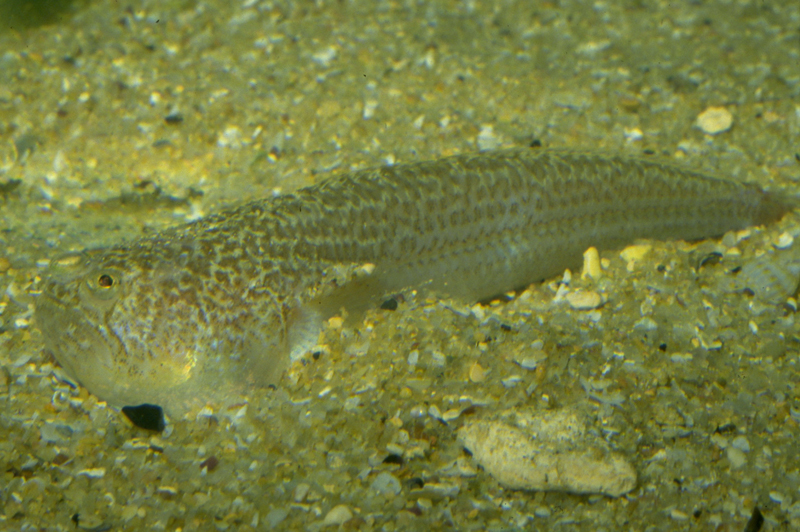Pink Sandfish, Crapatalus munroi Last & Edgar 1987
Other Names: Munro's Pygmy-stargazer, Robust Pygmy Stargazer, Robust Pygmy-stargazer, Stargazing Sandfish

A Pink Sandfish, Crapatalus munroi. Source: Rudie H. Kuiter / Aquatic Photographics. License: All rights reserved
Summary:
A whitish sandfish with numerous small, irregular brownish to golden markings denselt covering the upper half of the body and extending onto the upper parts of the dorsal, pectoral and caudal fins. Body white; upper half densely covered with numerous small, irregular brownish to golden markings which extend onto upper pectoral, dorsal and caudal fins. The well-camouflaged Pink Sandfish usually lies partly buried in sand.
Cite this page as:
Bray, D.J. 2020, Crapatalus munroi in Fishes of Australia, accessed 10 Jul 2025, https://fishesofaustralia.net.au/home/species/507
Pink Sandfish, Crapatalus munroi Last & Edgar 1987
More Info
|
Distribution |
Gippsland Lakes, Victoria, to the Great Australian Bight, South Australia, and possibly west to Esperance, Western Australia, and around Tasmania. Inhabits shallow sandy areas in coastal water, bays and harbours, often lying partly buried in sand. |
|
Features |
Dorsal fin 36-38; Anal fin 36-37; Caudal fin 10; Pectoral fin 21-23; Pelvic fin I, 5; Lateral-line scales 46-49. Body elongate, compressed, tapering to caudal fin; maximum depth 4.0-5.2 in S.L; head bulbous, rounded or slightly compressed, about 4 times wider than the body. Fimbrae simple on jaws, sometimes bifurcated on operculum, not papillated, 34-42 on lower jaw; 23-31 on upper jaw; 13-19 on operculum. Eyes dorsal, situated close to snout; interorbital distance short, less than three quarters tranverse eye diameter. Mouth almost vertical; maxilla extending to below anterior margin of eye. Teeth small, caniniform; in narrow bands in jaws and on palatines; two separate patches present on vomer. Isthmus without lappets. Scales cycloid, large, covering trunk, and pectoral and caudal fin. bases; head naked except for small scaly patches on upper preoperculum and operculum; prepelvic area scaled. Dorsal and anal fin bases elongate, former shorter; rays short, simple. Pectoral fin large (21.7-24.4% S.L.), pointed; rays 8-9 generally longest, decreasing in length ventrally; upper part only slightly incised, rays mostly bi- furcated; lower part moderately incised, rays divided into 4-6 portions. Pelvic fins jugular; inserted close to pectoral fin bases, shortest distance between them less than half interpelvic distance; extending posteriorly well behind anus. Caudal fin short, truncate. |
|
Feeding |
Ambush predator. |
|
Similar Species |
The similar Flathead Sandfish, Lesueurina platycephala, has a shallower body (vs. deeper body in C. munroi), scales absent from the front part of the pectoral-fin base (vs. front part of pectoral-fin base covered in scales), the closed mouth directed obliquely upward at a shallow angle, not nearly vertical (vs. closed mouth directed almost vertically upward), the dorsal profile of the head weakly to moderately convex, not horisontally in line with dorsal profile of trunk ( vs. dorsal profile of the head horizontal, in line with the dorsal profile of the trunk). |
|
Etymology |
The species is named in honour of Mr I.S. Munro, an eminent student of ichthyology, who discovered the species. |
|
Species Citation |
Crapatalus munroi Last & Edgar, 1987, Mem. Mus. Vic. 48(1): 73, fig. 1.Type locality: D'Entrecasteaux Channel, Verona Sands, Tasmania, Australia, 43°17'S, 147°09'E, depth 1 metre. |
|
Author |
Bray, D.J. 2020 |
|
Resources |
Pink Sandfish, Crapatalus munroi Last & Edgar 1987
References
Edgar, G.J. 2000. Australian Marine Life: the plants and animals of temperate waters. Sydney : Reed New Holland Revised Edn, 544 pp.
Edgar, G.J. 2008. Australian Marine Life: the plants and animals of temperate waters. Sydney : Reed New Holland 2nd edn, 624 pp.
Glover, C.J.M. 1994. Family Leptoscopidae. pp. 717-718, figs 628-629 in Gomon, M.F., Glover, C.J.M. & Kuiter, R.H. (eds). The Fishes of Australia's South Coast. Adelaide : State Printer 992 pp. 810 figs.
Gomon, M.F. & Last, P.R. 2008. Family Leptoscopidae. pp. 676-677 in Gomon, M.F., Bray, D.J. & Kuiter, R.H. (eds). Fishes of Australia's Southern Coast. Sydney : Reed New Holland 928 pp.
Hutchins, J.B. & Swainston, R. 1986. Sea Fishes of Southern Australia. Complete field guide for anglers and divers. Perth : Swainston Publishing 180 pp.
Kuiter, R.H. 1993. Coastal Fishes of South-eastern Australia. Bathurst : Crawford House Press 437 pp.
Kuiter, R. & Kuiter, S. 2018. Coastal sea-fishes of south-eastern Australia. Seaford, Victoria : Aquatic Photographics, 371 pp.
Last, P.R. & Edgar, G.J. 1987. New Australian fishes. Part 16. A new species of Crapatalus (Leptoscopidae). Memoirs of Museum Victoria 48(1): 73-74 https://doi.org/10.24199/j.mmv.1987.48.16
Last, P.R., Scott, E.O.G. & Talbot, F.H. 1983. Fishes of Tasmania. Hobart : Tasmanian Fisheries Development Authority 563 pp. figs. (as Crapatalus sp.)




